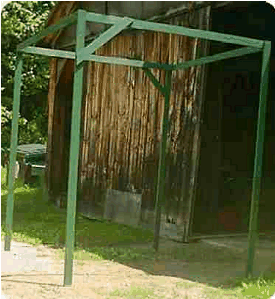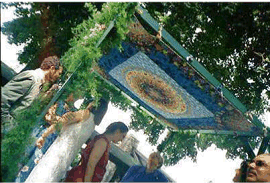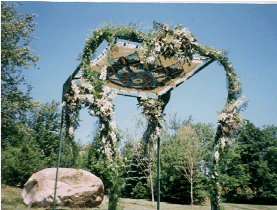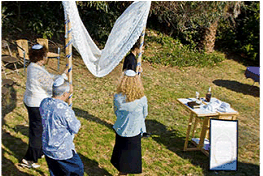
SOMETHING has to hold that chuppah aloft. Serendipitously-located trees, and wires hung from architecturally innovative huppah-retrofitted ceilings, are approaches that quilters have described to me. But in most wedding locations, neither of those is an option. You will probably need to choose between the four-pole approach, or a frame that you rent, buy, or build yourself.
Four Poles, People Optional
While short (2-3 foot) poles are sometimes used, I just don't like them; they must be held aloft, which is tough on chuppah-holders' arms. This is especially true with a heavier quilted chuppah. I prefer the bottom of the pole to rest on the ground, and the top to be high enough to clear the tallest person who will stand under it, plus a few inches for 'sag!' For tall poles, consider:
- Bamboo The least expensive, most environmentally correct and convenient choice. Find bamboo poles in the garden section of a hardware/home improvement store. They cost maybe $3 each. Sometimes they're a bit grubby and have splits, but with a cleaning, and then wrapping with ribbon and or foliage, no one will notice. (I used them recently for my cousin's wedding, right. She used an heirloom lace bedspread as an actual topper).
- Closet rods and drapery poles. A more substantial choice. They're sold in hardware stores and home improvement centers. (Around here, they're 8' long and cost $8 each.) Drapery poles may have a decorative topper.
- PVC poles (over 1" thick) can work, though of course you will want to cover them completely with fabric sleeves, foliage, and/or ribbon. (I don't find undressed PVC very romantic, unless the bride and/or groom happens to be a plumber, and they met during a repair job).
With or without people at the poles, you may want to plant the base of the poles for extra support. Plant them in:
- Deep baskets or flower pots, filled with sand, sand bags, gravel, or rocks. (Flowers on top will disguise the contents). You can even use cement .
- Plastic outdoor umbrella bases. From the home improvement center, they're filled with water or sand to stabilize, though you may also need to wrap the bottom of your poles in some duct tape, or towels, so they'll be gripped firmly). They cost about $10 each.
- Iron outdoor umbrella stands.High-quality ones have an adjustable screw to hold the pole securely, regardless of diameter. They're also often lovely, with decorative cast iron designs. These run about $25 each.
- Christmas tree stands. I kid you not. Very interfaith (or can be disguised with foliage), and $2 apiece at my local thrift shop.
The Chuppah Frame Game
If you have no chuppah holders, or your chuppah-holders are challenged in the upper-body strength department, or, if you have a really heavy, bed-sized, fully-quilted chuppah, consider a free-standing frame. Along with four vertical poles, a horizontal support around the top will help prevent sagging.
My friend Howie, a professional carpenter, built this elegantly curved frame for my 'Fire and Ice' chuppa (right).
Gary, a friend who describes his carpentry skills as "basic," built the second one. He brought it to the wedding disassembled, and we erected it on the spot, using an electric screwdriver. It held the chuppah strong and steady during a very windy ceremony. He painted it flat green, so it virtually disappeared behind the floral decorations.
Before you whip out the power tools, call your florist and ask if they have a chuppah frame. Jewish bookstores and supply stores often rent them, as well. Ask the dimensions, and the florist will help you figure out how to make it work.
If you have no florist, no Jewish supply store, and when you say "chuppah," your florist says "gezundheit!" (also try the words "wedding arch" and "wedding canopy,"), you can make a chuppah frame yourself, with basic carpentry skills and tools.
Finally, if you don't have a strong chuppah holder, you cannot build a frame, or your chuppah quilt isn't done in time, there's another option: Use an unfinished single-layer top of a quilt. You can baste a temporary backing to it, if the back is messy. It will be light enough to be held up by thin poles held by non-iron-pumping friends or family. Then, finish it as a quilt later, after the wedding. (The permanent backing can be set out on a table for guests to sign - see 'Group Projects').
Four bamboo poles make a strong support, in this case for an heirloom lace bedspread The fabric was gathered and wired to the top of each pole, at the corners, just before the ceremony to reduce chances of tearing. The four attendants marched with it to the front at the start of the ceremony, keeping a close eye on each other to avoid pulling or tearing! Photo by Mark Reden, www.Markreden.com.
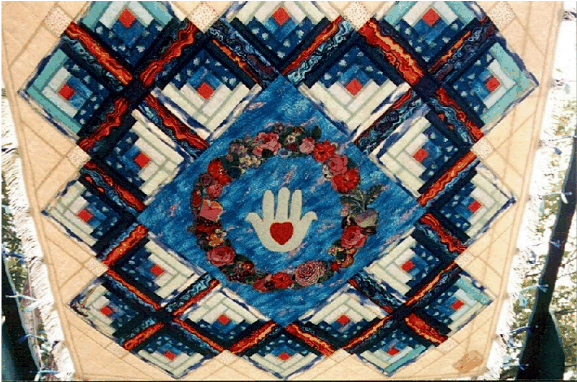
RETROFITTING THE QUILT FOR SUSPENSION (OR NOT)
Whether you use four poles, or a frame, you will need to attach the corners (and maybe the sides) of the quilt fabric to the hardware. Some approaches.
1. Decorative Smush-Gathering. Place the corners of the chuppah over the pole, gather a few inches down, then wrap with strong wire. Cover the wire with foliage or ribbon. This works best if you have a very large and unquilted chuppah (I used it with the lace bedspread chuppah in the photo above). But it uses up more fabric, and may not give the neatest effect, especially with a quilt.
2. Fabric or ribbon ties. This is my preference for a real quilt that I don't want to distort. I sew ties to all four corners, with a zig-zag stitch, just inside the binding. After the ceremony, remove them with a seam ripper. (Never go anywhere without a seam ripper. Except airplanes). With poles, you only need ties at the four corners. If you have a frame that circles the circumference of the chuppah (below), sew ties every foot or so. A 24" strip folded in half makes two 12" ties. Machine stitch through the center.
3. Buttonholes, grommets, or rings. You can sew a buttonhole in the corners of your quilts, through all the layers Ribbon or wire can then be strung through the holes to encricle the poles. Grommets are hammered into holes in the fabric (you can find a grommet kit in your fabric store)Again, wire or ribbon is slipped through the grommet, and around or through the top of the pole. Metal rings can also be sewn to the quilts corners.
